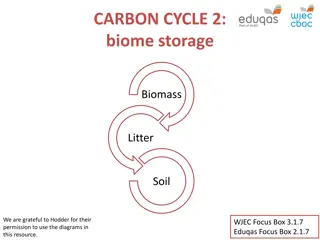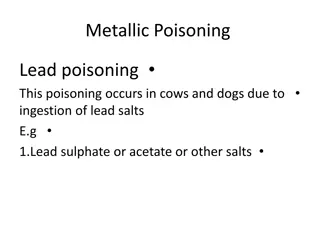Understanding Carbon Monoxide Poisoning: Risks, Symptoms, and Guidelines
Carbon monoxide poisoning is often unrecognized and underdiagnosed, leading to serious health risks including chronic symptoms if left untreated. This article discusses the prevalence, symptoms, long-term effects, WHO guidelines, UK workplace guidelines, and CO levels in various environments. Awareness and adherence to safety protocols are crucial in preventing CO poisoning incidents.
Download Presentation

Please find below an Image/Link to download the presentation.
The content on the website is provided AS IS for your information and personal use only. It may not be sold, licensed, or shared on other websites without obtaining consent from the author. Download presentation by click this link. If you encounter any issues during the download, it is possible that the publisher has removed the file from their server.
E N D
Presentation Transcript
Carbon monoxide Poisoning Robert Florance Accident and Emergency Department Queen Elizabeth Hospital, 1 Kings Lynn. PE30 4ET
Introduction Unrecognised and underdiagnosed 50 accidental deaths from acute CO poisoning in England and Wales each year 200 / yr non-fatal CO poisonings requiring hospital admission More than 200 /yr attendances to A&E with poisoning requiring treatment but not hospital admission? Many more exposed but not recognised? USA: 1/3 cases unrecognised? Poisoning may be incidious Easily treatable if identified early Pitfalls 4
Chronic / long term sequalae if treatment delayed Headaches Lightheadedness Depression Confusion Memory loss Nausea and vomiting Hallucinations Mutism Psychosis incontinence Emotional lability Ataxia Seizures Cortical blindness Atherosclerosis? Polycythaemia? Cardiomegaly? almost any conceivable neurological or psychiatric syndrome? (Kao et al 2004) 5
WHO Guidelines So that blood Carboxyhaemoglobin levels of 2.5% are not exceeded. 100 mg/m3 (87 ppm) for 15 min 60 mg/m3 (52 ppm) for 30 min 30 mg/m3 (26 ppm) for 1 h 10 mg/m3 (9 ppm) for 8 h (Footnote: smokers, baseline is 5 10%; sometimes as high as 13% immediately after a cigarette; non smokers, 1 2%. CO from normal haem breakdown accounts for 0.5% of this) (WHO 2010. https://www.ncbi.nlm.nih.gov/books/NBK138710/) 6
UK workplace guidelines HSE 2020 https://www.hse.gov.uk/pubns/books/eh40.htm 7
CO levels in various environments http://en.wikipedia.org/wiki/Carbon_monoxide_poisoning Concentration 0.1 ppm 0.5 to 5 ppm Source Natural atmosphere level. Average level in homes. Near properly adjusted gas stoves in homes. Exhaust from automobiles in the Mexico City central area. Exhaust from a home wood fire. Undiluted warm car exhaust without a catalytic converter. 5 to 15 ppm 100 to 200 ppm 5,000 ppm 7,000 ppm 8
Acute exposure, concentration, and symptoms (After http://en.wikipedia.org/wiki/Carbon_monoxide_poisoning) Concentration Symptoms Headache and dizziness within six to eight hours of constant exposure Slight headache in two to three hours Slight headache within two to three hours; loss of judgment Frontal headache within one to two hours Dizziness, nausea, and convulsions within 45 min; insensible within 2 hours Headache, tachycardia, dizziness, and nausea within 20 min; death in less than 2 hours Headache, dizziness and nausea in five to ten minutes. Death within 30 minutes. Headache and dizziness in one to two minutes. Convulsions, respiratory arrest, and death in less than 20 minutes. Unconsciousness after 2-3 breaths. Death in less than three minutes. 35 ppm (0.0035%) 100 ppm (0.01%) 200 ppm (0.02%) 400 ppm (0.04%) 800 ppm (0.08%) 1,600 ppm (0.16%) 3,200 ppm (0.32%) 6,400 ppm (0.64%) 12,800 ppm (1.28%) 9
Mechanism of Toxicity Various mechanisms: Binding to haemoglobin Direct cellular toxicity Binding to proteins Release of Nitric Oxide (NO) and other Oxygen free radicals Lead to various clinical consequences 10
Binding to Haemoglobin Haemoglobin has 230 times the affinity for CO as it does for O2 Hb is a tetramer If CO binds even just one of these sites, it increases the affinity of Hb to O2, holding on to it when in fact it should be delivered to tissues. left shift of O2 dissociation curve. Paradox of high blood O2 levels but tissue hypoxia. Relative anaemia 11
Cherry red appearance is more often seen in the dead So it is not considered a useful sign in clinical medicine . https://en.wikipedia.org/wiki/Carbon_monoxide_poisoning 12
Direct cellular toxicity Goldbaum et al. 1975 Dogs breathing 13% CO died within 1 hour CO levels were 54% - 90% If did exchange transfusion with blood with CO-Hb of 80% in otherwise healthy dogs, ended up with Co-Hb of 57%-64% but all survived, with no toxic effects. CO-HB levels correlate only weakly with toxic effects. 13
Protein binding Haem is not only in haemoglobin Cytochromes Myoglobin Guanylyl cyclase 14
Cytochromes Binds to cytochrome aa3 Disrupts aerobic oxygenation by inhibiting cytochrome oxidase However, since binds with less affinity than oxygen does, tends to occur where high levels of hypoxia. Inactivation of other mitochondrial enzymes Impaired electron transport of oxygen radicals which are produced after CO exposure. Eg peroxynitrite High levels of anaerobic metabolism Lactic acidosis. Toxic effects of CO take longer to correct at cellular level than CO-Hb levels. 15
Myoglobin CO binding to myoglobin may reduce O2 availability in the heart Arrhythmias Cardiac dysfunction Direct skeletal toxicity rhabdomyolysis 16
CO also stimulates guanylyl cyclase increases cyclic guanosine monophosphate Leads to in cerebral vasodilation, Associated with LOC at least in animal models. 17
Nitric oxide and other oxygen free radicals. CO seems to cause release of NO endothelial relaxation factor . May cause LOC or syncope with CO exposure Cerebral vasodilation (see above) Peripheral vasodilatation and hypotension? The presence of systemic hypotension in CO poisoning is correlated with the severity of cerebral lesions, however, particularly in watershed areas of perfusion (ie, basal ganglia, white matter, hippocampus). CO displaces NO from platelet surface haem proteins, inhibiting mitochondria, increasing platelet activation, and thus stimulating inflammatory cascade 18
NO seems to start a cascade of events, causing oxidative damage to the brain may affect neutrophil adherence to the endothelium, (? by affecting the function of neutrophil adhesion molecules eg b2-integrin) Neutrophil adherence leads to xanthine oxidase activation, oxidative radical formation, oxidative damage, and ultimately brain lipid peroxidation and demyelination during reperfusion of previously iscahemic areas of the brain. This is thought to account for CO tendency to cause Delayed Neurological Sequelae . DNS are likely to be more severe if there has been hypotension or loss of consciousness. 19
Areas particularly affected: Cerbral white matter including cerebral cortex Basal ganglia Globus pallidus Regulation of subconscious movement; help create smooth movements Cerebellum Co-ordination, posture, speech Hippocampus Learning and memory 20
Pregnancy CO-Hb reduces thte release of oxygen by maternal blood, to the foetus across the placenta. (CO-Hb hold onto the oxygen) CO can cross the placenta Foetal haemoglobin has 10-15% higher affinity for CO than normal haemoglbin CO tends to accumulate in the foetus. Foetus is particularly senstive both to toxicity and to hypoxia. 21
Causes Incomplete combustion of all carbon- containing fuels 22
Gas Stoves Fires Boilers Water heaters Paraffin heaters Room heaters Portable electricity generators Vehicle engines (Ventilation) Domestic, bottled Coal Coke Diesel; petrol Barbecue charcoal Wood Biofuel Plastics Chemicals 23
(Not domestic gas leaks any more) Caravans Mobile homes Boats Holiday homes Shared accommodation Rented accommmodation Any accommodation Faulty air compressors in scuba divers Electrical power failures Turkish water pipes Tents? 24
Acute presentation Headache Nausea and vomiting Irritability Weakness and tachypnoea Followed by: Dizziness Confusion Ataxia Agitation Syncope Hypotension Seizures Impaired consciousness Respiratory failure Cerebral oedema Metabolic acidosis Clonus and hyperreflexia; extensor plantars 25
Commonly reported symptoms Headache Nausea and vomiting Vertigo Alteration in consciousness Subjective weakness Frequency (%) 90 50 50 30 20 26
Less commonly: Skin blisters Rhabdomyolysis Compartment syndrome Acute renal failure Pulmonary oedema Dysrhythmias Myocardial infarction Retinal haemorrhages Cortical blindness Choreoathetosis Mutism Cherry red skin colour (dead .) 27
Delayed features Memory impairment Disorientation Apathy Mutism Irritability Inability to concentrate Personality change Emotional lability Neuropathy Incontinence Chorea Apraxia Psychosis Dementia Parkinsonism Particularly when serious poisoning or unconsciousness Onset may be delayed sometimes days (up to 40) More common in over 40s 28
50% of patients who develop delayed features start to show them in 2-4 weeks after the acute exposure 25% start earlier 25% start later 75-80% recover completely or improve considerably in 1 year 29
Chronic poisoning Much more likely to be undiagnosed Faulty heating Poorly ventilated areas Winter months? House spouse versus wage earner Headache Lethargy Nausea Hearing problems Flu-like symptoms Memory problems Said to sometimes seem like gastroenteritis, especially as other family members may be symptomatic Some of the delayed features 30
Diagnosis Clinical suspicion CMO recommends suggests that GPS will have access to breath CO detectors from smoking cessation clinics. (smoking up to 70ppm; derived CO-Hb about 12%) However, low concentrations (less than 5ppm), probably exclude recent CO exposure, but this cut off value cannot be used if several hours have elapsed since exposure. Hence importance of prompt diagnosis (and the advice for GPs to use breath CO detectors for screening, rather than sending all cases to hospital for phlebotomy there). 31
Examination (concurrent with treatment, using ABC principles) For burns / smoke inhalation General examination and tests - including respiratory, cardiac , GI and GU. Neurological examination where there is any suspicion of neurological abnormality. Include: Fine movement and balance (finger-nose test; Rombergs test, gait, heel-toe walking) Mini mental state examination Short term memory Serial 7s from 100 32
Tests TPR SaO2 ECG (monitoring and 12 lead) Pitfalls of SaO2 monitoring CO-oximetry? Remember to follow the manufacturer s instructions and precautions. Eg Masimo Rad-57 CO levels More accurate than CO-oximetry Consider FBC, U&E, CK, troponin, ABG. Eg polycythaemia Consider CXR, ECG 33
In selected cases, depending on clinical findings and clinical progress: CT brain MRI brain 34
Treatment (Safe approach. Start process of making the scene safe. Fire brigade? Police? National Grid ? Health protection agency?) ABC Remove from danger / remove from exposure Give as high a concentration of oxygen as possible through a tight fitting mask Half life of CO is 320 minutes breathing air Can be reduced to 80 minutes breathing 100% oxygen Reduces to 22 minutes with hyperbaric oxygen at 2.4 atm Nasal high flow oxygen best of all. 35
Correct hypotension initially with fluids Persistent hypotension may be due to reduced systemic vascular resistance, metabolic acidosis of reduced myocardial contractility or arrhythmia. Each may need to be checked and treated, including metabolic acidosis using sodium bicarbonate, (although caution as may impair release of O2 to tissues). If greatly increased muscle activity, may need dantrolene, or diazepam or both Cerebral oedema may require mannitol 36
Advice found on Toxbase on 12/4/12 is different in key areas compared with advice in Bateman DN. Medicine 2012 40(3) Areas of difference include caution with fluids, caution with bicarbonate, and mention of mannitol and dantrolene / diazepam in Bateman s article. 37
Hyperbaric oxygen Coal gas Coal gas in its unburned form contains CO. When natural gas replaced coal gas from the 1960s onwards, the all cause suicide rate fell by 1/3, and has not risen since. Accidental poisonings also reduced. Fewer hospitals now have hyperbaric chambers available as a result Patients have to be transported much further for treatment in a hyperbaric chamber St Andrews Centre Burns Centre does not have a hyperbaric chamber, and neither does Chelsea / Westminster. 40
Toxbase no longer routinely recommend hyperbaric oxygen for CO poisoning But always phone NPIS if you think you have a patient that might benefit. CO-Hb > 20% and LOC at any stage Neurological / psychiatric signs other than headache Myocardial ischaemia / arrhythmia on ECG Pregnancy May be considered for patients with lower CO-Hb levels if extensive / chronic exposure is suspected and neurological / psychiatric features. 41
Reasons hyperbaric O2 is contraversial for CO poisoning include: uncertainties about the best regime methodological issues relating to published studies Concern about transferring potentially unstable patients a long distance to a referral centre. Nearest to QEH is at Great Yarmouth. https://www.jpaget.nhs.uk/departments-services/departments-services-a- z/hyperbaric-chamber/ https://www.lhmhealthcare.com/about-us/our-great-yarmouth-facility/ 42
Indications of severity One or more of the following: Any new objective acute neurological signs. Eg increased tone, upgoing plantars, coma Need for ventilation ECG evidence of infarction or ischaemia Clinically significant acidosis Initial carboxyhaemoglobin greater than 30% 43
Do patients still get poisoned from car exhausts? 44
Catalytic converters foil suicide bids Tuesday, October 27, 1998 Published at 04:21 GMT Health http://news.bbc.co.uk/1/hi/health/201873.stm More than 1,000 deaths could have been prevented in England and Wales because catalytic converters make it harder to commit suicide through carbon monoxide (CO) poisoning. Research by the University of Birmingham's Medical School shows that successful suicides through CO poisoning have been falling since 1992, when catalytic converters became compulsory on new cars sold in the UK. The researchers say that, if their data on the West Midlands area were applied to England and Wales, 950 people would not have died between 1991 and 1994 45
Carbon Monoxide. General Information. Bull G (HPA 2009) http://www.hpa.org.uk/webc/HPAwebFile/HPAweb_C/1202487036268. Production of carbon monoxide increases when cars are moving slowly hence levels of carbon monoxide in the atmosphere are higher near busy roads during peak times when the flow of traffic is slow. Carbon monoxide production increases when the engine is cold, as catalytic converters take time to reach the operating temperature and thus petrol engine cars in closed garages are dangerous even with a catalytic converter. Levels may also increase in winter due to periods of still cold air as this affects the dispersal of carbon monoxide, as it is usually rapidly dispersed away from roads and destroyed by photochemical reactions over a period of months 46
Thomas Greiner, an agricultural engineer from Iowa State University, http://www.extension.iastate.edu/pages/communications/co/co_car.html Greiner conducted an investigation at a central Iowa home where the family was diagnosed with carbon monoxide poisoning and treated with oxygen. The husband typically opened the overhead garage door in the attached garage, started his small pick- up, let it warm for one or two minutes, drove out, shut the garage door, and left for work. His wife, who works in a home office, often developed late morning headaches. The family installed a carbon monoxide alarm. It sounded an alarm several hours after the truck was driven from the garage. Repeating the sequence of events, Greiner found that after only two minutes of warm-up in the opened garage, carbon monoxide concentrations rose to a lethal 575 parts per million. Within one minute, measurable levels of CO seeped into the house and after only 45 minutes the level in the house rose to 23 parts per million. Eight hours later carbon monoxide concentrations still remained above the allowable 9 ppm. To prevent carbon monoxide poisoning from vehicles: NEVER run engines in a garage, even if the garage door is open. Make certain all vehicles are tuned up and running clean. Check and repair exhaust system leaks. 47
Suicidal asphyxiation by inhalation of automobile emission without carbon monoxide poisoning DeRoux S.J. Journal of Forensic Sciences, September 2006, vol./is. 51/5(1158-1159), 0022-1198;1556-4029 Reported herein is the suicidal asphyxiation of a young man due to exhaustion of oxygen in the interior of a sealed automobile into which the exhaust emissions were diverted. His blood carboxyhaemaglobin concentration was less than 5% saturation. The car was equipped with a catalytic converter and when tested, the exhaust carbon monoxide concentration was 0.01%. 48
Non flame gas heaters http://www.gearreview.com/blackc at.asp The Black Cat's catalytic heat source burns cleanly, i.e. the surrounding air must drop to a very low level of oxygen before it produces measurable levels of carbon monoxide. Normal air contains an average of 21% oxygen; the Black Cat burns cleanly down to about 9 to 12% oxygen. To maintain the proper oxygen level, Coleman specifies that you keep at least a six-inch long opening for ventilation. 49
Breysse P.A. 1981 Unvented catalytic heaters have been advertised as being, producing no dangerous concentrations of carbon monoxide. Results of a limited catalytic heater testing program indicated that oxygen deficient atmosphere involving high concentrations of carbon dioxide and low levels of carbon monoxide were possible in areas with limited ventilation. It is concluded that no unvented heater, including catalytic heaters, should be utilized in indoor areas. 50























